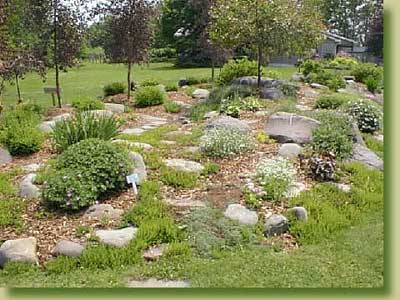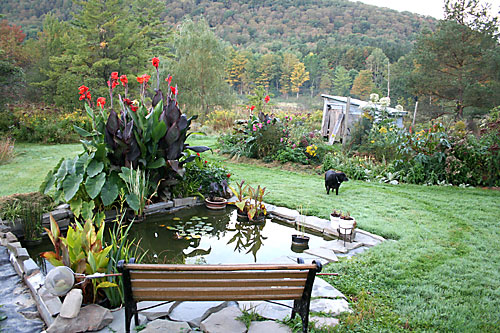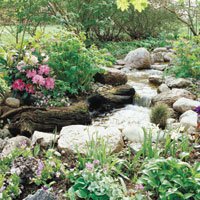Types of Gardens
By: Robyn Thoennes
Horticulture Plant Science - NDSU
Gardens are a wonderful way to add character to your yard. They can be designed in many different shapes, sizes, and designs. Adding an assortment of plants, flowers, and decorations all add to the beauty of your yard and home. Most types of gardens can function in aesthetic ways, but often times there are additional functions related to each type. Gardens are categorized according to the types of plants present, as well as, the style and function of the garden.
In this article, you will find different garden designs, suitable plants for each type, and a few steps to get you started. I will be discussing three different styles of gardens, including decorative shade gardens, rock gardens, and water gardens. Rock gardens and water gardens are classified as specialty gardens, so if you are a beginning gardener, you may want to start with the more simple shade garden. Each of these garden types is characterized by specific plants and follows a specific style. I have also included, at the end of this article, a few general steps to help you get started on any type of garden design.

Decorative Shade Gardens:
The term shade is used to classify an area that does not receive full sunlight. The amount of shade received in an area can vary greatly based on the time of day and the season. When it comes to gardening, people often think that shade is a bad thing; that shade is often thought of as a place where nothing grows and especially a place where no colorful plants bloom. This is not true however. Partially shady areas are ideal places to put a beautiful garden. By finding the right plants and adding the proper décor, shade gardens can function as peaceful and relaxing locations to enjoy nature, all while staying out of the hot summer sun.
There are a few conditions that must be considered before planting your shade garden. First, you will want to find a location that is partially shady; only receiving a small amount of sunlight each day. The soil in your shade garden should be free of large rocks and other debris, and should contain an abundance of organic matter. A good drainage system is also needed for your shade garden.
There is a large variety of plant types that can be planted in your shade garden. They vary greatly and include both annuals and perennials. The plants you will be picking from are categorized as being either full shade or partial shade. Either category will be sufficient depending on where in your shade garden they are planted. Below is a list of examples of shade garden plants.
Partial shade:
- Bleeding heart (Dicentra species)
- Cardinal flower (Lobelia cardinalis)
- Primrose (Primula species)
Full shade:
- Hosta (Hosta species)
- Lungwort (Pulmonaria officinalis)
In addition to plants, garden furniture and other decorations can be added to your garden. Finding a decoration theme to follow is best, and from there, you can simply find decorations that follow your theme. Benches, tables, and ceramic statues, for example, can add a great deal to your shade garden. The goal of adding decorations to the garden is to make it a more relaxing and welcoming area.

Rock Gardens:
Also known as Alpine gardens, rock gardens are designed to utilize a small amount of space and follow the rugged mountainous style. Rock gardens can simply add character to a small space, but also function to take the place of the lawn on a steep hillside. This type of garden is ideal if you are limited on space, or if you have a hillside that is difficult to care for. The plants in this garden type are similar to those found in rocky regions and require special conditions. Theses plants are very hardy and are able to survive conditions similar to those in mountainous regions. The main thing to remember about this type of garden is that the best rock garden is the most natural one. The more natural the plants and rocks are placed, the better your garden will look.
Again, there are some conditions that should be considered before beginning your rock garden. First, you must find a location for your garden. Rock gardens are usually located in a sunny area on a natural slope or terrace. The soil medium should consist of a mixture of sand, gravel, and organic matter. A good drainage system, with low to moderate watering, is also needed. When finding rocks to add to your garden, only chose one rock type, but with varying sizes. These rocks should be placed in a way such that they look as natural as possible.
When choosing plants for your rock garden, choose ones that are generally low growing and have a clumping habit. The plant species you choose should be repeated several times throughout the garden to give it a more natural appearance. Below is a brief list of plants that work well for rock gardens.
- Creeping baby’s breath (Gypsophila repens)
- Basket-of-gold (Aurinia saxatilis)
- Mountain alyssum (Alyssum montanum)

Water Gardens:
Water gardens are the dream of many, and with proper planning, one can be created. Water gardens can be placed in any location, but the location may become limited depending on what types of plants are in the garden. The first step in building a water garden is to find a place large enough to build a pool of desired size. The shape and size of the pool depends on what style you would like to follow, and how it will fit in with the rest of your yard. Once the pool is designed, plants can be added. There are several different types of water plants, each having its own function in the pool. Adding plants to the water garden has many benefits. They filter and purify the water, as well as, keep the water cool by sheltering it from sunlight. Keeping the water cool is necessary if you plan to add animal life to your water garden.
There are five major types of water garden plants. The first type is the floating plants. Floating plants float on surface of the water garden. They help cut out sunlight, filter the water, and nourish fish that may be present. Two common examples of floating plants include duckweed and floating ferns. Submerged plants are another type of aquatic plants. They are completely submerged under the water, but are essential to the pool because they oxygenate and filter the water. It works best to plant these plants in containers and then place them under water. Emerged plants are the next type of water plant. They have roots that are anchored in soil but have leaves that rise above the water level. Emerged plants help to cut out sunlight, as well as, filter and oxygenate the water. Common examples of emerged plants include water lilies and lotus. Bog plants are similar to emerged plants except their roots are not entirely emerged in the soil. Examples of bog plants include cattails and pickerel rush. The final type of aquatic plants is basic garden plants that are able to grow in marshy conditions. Common examples of these include forget-me-nots, bee balms, moneywarts, and the chameleon plant.
Having animal life in your water garden is a fun way to make your garden more unique and attractive. Goldfish are the main type of animal added to water gardens. They are relatively easy to care for and add a great deal of beauty and excitement to the garden. Japanese carp, or Koi, as well as, some scavengers can also be added to your garden as well. Scavengers help to keep the water clean and include species such as snails, tadpoles, and freshwater clams.
An important thing to remember about gardening is that it is your hobby so you can do it in any way you would like. Gardens can follow certain guidelines, but still fit in with your likes. Decorations and other added features can be added to any type of garden. The main thing to remember is to make your garden look neat, friendly, inviting, and unique. The information provided above about garden types can help you decide which type of garden is right for you and your yard. The tips that follow can help you get started on the garden design you pick.
Tips for Starting a Garden:
The first step to beginning any garden is to make a plan. Assess your garden conditions and determine the best location. Decide what type of garden you would like to plant. The second step to beginning your garden is to prepare the garden soil. Remove rocks and stones from the planting area, as well as, any unwanted debris. Fertilize the soil, and assure that there is a good mixture of clay, silt, and sand. Next you can decide which plants will do well in your garden, and then buy the plants. Buy healthy looking plants that will thrive in your particular garden setting. The final step to obtaining your desired garden is to care for it. Water the plants as needed and control pests and growth of unwanted plants. If you follow these general steps, you should be able to obtain a beautiful healthy garden just as you wanted. Don't be afraid to alter unwanted areas of the garden, or add plants and decorations to it. Remember, it is your garden; enjoy it!
